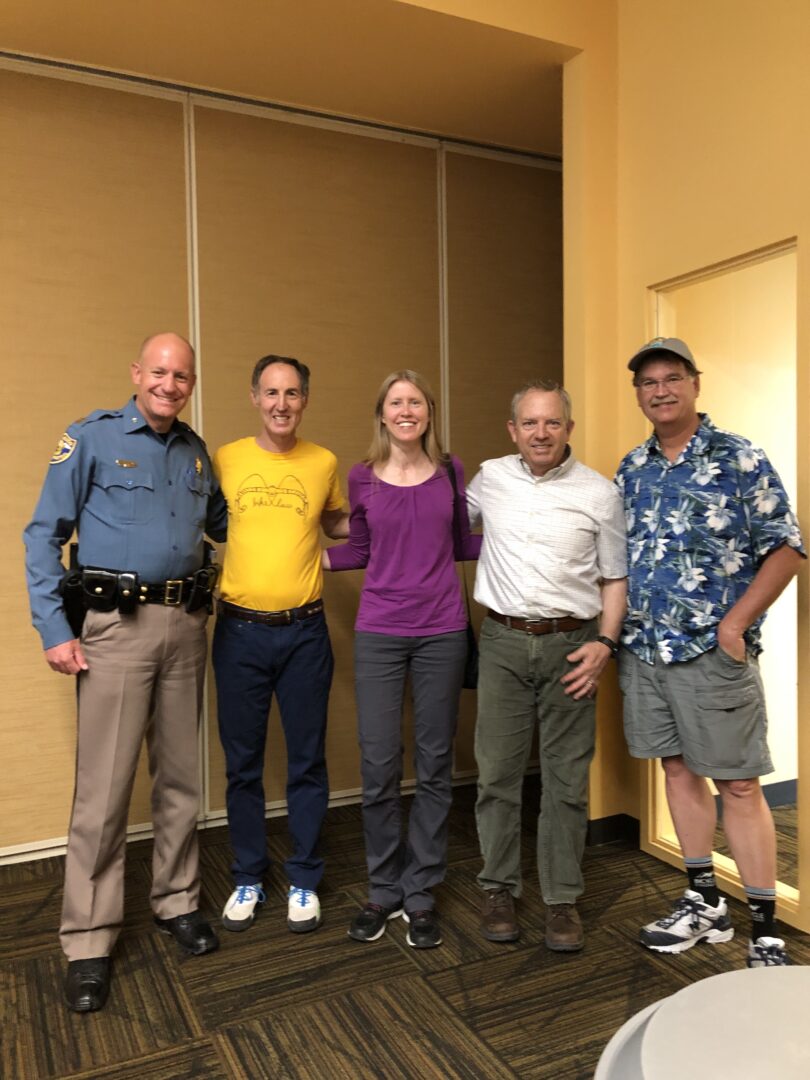
WORK WITH LAW ENFORCEMENT: BICYCLE CRASH INVESTIGATION BASICS
Anytime there is a bicycle crash, law enforcement should be contacted, and a crash report should be prepared. The crash report is an important piece of the puzzle for how a crash occurs and who is at fault. We have talked and given presentations to various police departments and worked with Colorado State Patrol about how to investigate and report on bicycle crashes.
The updated Colorado crash reports referenced and pictured below give more details than earlier versions and better document bicycle, motorcycle, and pedestrian crashes. The new form is called a DR3447 and is now used statewide, and it is legally called the “State of Colorado Traffic Crash Report.” This article is focused on educating law enforcement officers (LEOs) on what to consider upon arrival at the scene of a bicycle crash and is also helpful to anyone who is in or witnesses a bicycle crash.
We have also talked to LEOs recently and they are interested in the differences presented in bicycles crashes as compared to motor vehicles which are much heavier and leave debris after impact. We direct LEOs in Colorado to review these basics to complete a more balanced and complete report of a crash.
1.APPROACHING THE SCENE OF A CRASH
- Be Wary of the “Windshield Perspective.” Recognize that in a car-oriented society, many people perceive bicycle crashes through the lens of a motor vehicle operator and fail to consider the events leading up to the crash and the crash from the perspective of a bicyclist. Be cognizant of this tendency when interviewing witnesses and assessing a crash scene.
- Understand that Bicycles are “Traffic.” Under Colorado Law, bicycles are included in the definition of traffic and bicycle riders generally have the same rights and duties as the operators of vehicles. There are some exceptions so contact BikeLaw.com or Denverbicyclelaw.com for questions on your specific issues. Be careful not to assume that because a road is dark, busy, or dangerous a bicycle rider does not belong.
- Make Balanced Inquiries. Investigate evenhandedly. For example, if collecting information on conspicuity, don’t just investigate what a bicyclist was wearing and using for lights and reflectors. Investigate whether the motor vehicle operator involved in the crash had headlights and whether they were on, clean and functioning well enough for the operator to see objects (including bike riders) within 200 feet.
2.ASSESSING THE BICYCLIST AND BODILY INJURY
- Identification/Medical Tags. Check for ID and medical bracelets and tags. These often contain important identification, medical, allergy and prescription information.
- Assess for Head and Other Injuries. Recognize that bicyclists are particularly susceptible to head and other serious bodily injuries even in low speed crashes.
- Ask about points of impact (e.g. head to pavement, head to windshield, etc.).
- Check helmet and motor vehicle for damage that might signal injury (e.g. helmet or vehicle denting, cracking, etc.).
- Recognize that signs and symptoms of serious injuries may not present immediately(e.g. deep vein thrombosis and post-concussive syndrome).
- Superman/Superwoman Mentality. Recognize that many bicycle riders may act stoic and mask pain at the scene of a crash, but this does not mean that they do not need an ambulance or other medical assistance.
- Rider Likely More Injured Than His/Her Bike. Appreciate that it is common for concussed, shocked and confused injured bicycle riders to focus on their bicycle more than their injuries; don’t dismiss potential injuries because of this behavior.
- “Bodily injury” for Accident Reporting Statute. Remember that a crash report needs to be completed when a bicycle rider suffers any bodily injury—it does not need to be serious bodily injury or death. Note that serious bodily injury or death get different codes on crash reports.
3.TAKING INVENTORY OF ELECTRONIC DEVICES
- Bicycle. Investigate and take steps to preserve data from recording devices, such as those collecting footage and tracking speed, distance and location (e.g. Garmins, GoPros, Cycliqs, bicycle cameras, speedometers, cell phones, smart watches (like Apple Watch or Garmin, etc.).
- Motor Vehicle. Investigate and take steps to preserve data from recording devices, such as those collecting footage and tracking speed, distance, braking history, signal use, location and movement (e.g. on-board cameras, GPS devices, cell phones, event data recorders, industry-specific devices and tracking systems).
4.EXAMINING ROAD AND SURFACE CONDITIONS
- Widths. Measure the width of the way, including the traffic lanes and the shoulder. Assess whether the traffic lane where a crash occurred was standard or substandard width (less than 14 feet).
- Surface Conditions. Examine not only how the weather impacts surface conditions, but also look for things like loose gravel, sand piles, potholes, alligator cracking, slippery painted surfaces. These conditions may impact operational choices and pre-crash maneuvering.
- Object and Hazard Assessment. Assess for hazards in the immediate vicinity of the crash scene, as well as those ahead of and behind the crash scene.
- Crash Debris. Look for and document the location of crash debris.
5.THINKING COMPREHENSIVELY ABOUT SPEED
- Think Beyond the Posted Speed Limit. Regardless of the posted speed limit, consider whether all parties’ chosen speeds were “reasonable and proper having due regard to the traffic, surface and width of the way and of other conditions then existing.”
- Evaluate Data from Devices. If available, evaluate GPS and speed data from electronic devices.
- Time/Distance Analysis. Consider doing a time distance analysis.
- Distance to an Upcoming Intersection. Measure the proximity of the crash to the nearest intersection and analyze how that relates to safe speed for that time and place.
6.ASSESSING BICYCLE AND OTHER PROPERTY DAMAGE
- Avoid Assumptions. When conducting a post-crash assessment of a bicycle, avoid assumptions about broken and hanging/dropped chains causing a crash. Often chains fall off in a crash. Similarly, avoid other assumptions about damage and/or broken parts of a bicycle.
- Valuing Property Damage for “Accident Reporting” Statute. When valuing property for the accident reporting statute recognize that many road and commuter bikes are worth far more than the $1,000 property damage and many road bikes are made of carbon fiber valued over $5,000.00. Also, note that the structural integrity and safety of most carbon, steel and aluminum bikes is compromised after a motor vehicle crash, regardless of whether cracking is shown on the exterior of the frame. Further, note that damage to clothing and accessories counts towards that $1,000 threshold.
7.HANDLING THE BICYCLE POST-CRASH
- Track All Movements of the Bike from the Time of the Crash Forward. Find out where the bicycle was hit and/or initially crashed, where it (or pieces of it) landed, whether it was moved, etc.
- Take Measurements. Measure the distances between the initial crash / point of impact and where the bicycle landed, as well as the distance from the bicyclist and the bike post-crash.
- Preserve the Bike and Think About Chain of Custody Issues. Don’t leave the bicycle at the scene of the crash. Don’t turn the bicycle over to, or leave it in the custody of, the driver that hit it. Don’t release the bicycle to people at the scene of the crash, especially without the bicycle rider’s permission. Be careful when transporting the bicycle. Track the chain of custody.
8.INTERVIEWING WITNESSES AND PARTICIPANTS / PRESERVING WITNESS INFORMATION
- Statutory Mandate. Interviewing witnesses and participants is a statutory mandate, not just a suggestion.
- Comprehensive Contact Information. Record full contact information, including cell, home and work numbers, email and home and work addresses for witnesses and participants.
- Key Role of Witnesses in Bicycle Crash Cases. Appreciate that witness statements and recollections of events are particularly important in bicycle crash cases because bicycle rider victims are often not able to recall crashes and/or to offer details about the crashes, particularly when they are seriously injured, unconscious, concussed or deceased.
- Victim Inability to Collect Information. Understand that there is a huge disparity in the ability of the driver to collect witness statements and contact information and the ability of an injured bicyclist to collect this same information. Gathering full contact information and comprehensive witness statements from all persons with information regarding a crash helps to ensure that both the driver and the bicyclist have complete information, as well as ensures that the District Attorney can follow up with witnesses as necessary.
- Sample Areas of Inquiry Specific to Bicycle Crash Cases
- Signals: What pre-crash signals were used (or not used) by motor vehicle operator and bicyclist?
- Traffic Control Devices: What color lights and symbols were displayed by primary and secondary traffic control devices, including those governing crosswalk travel?
- Operational Decisions: Were there any movements from the lane, turns, changes in lanes or changes in speed post-crash? Was the bicycle operating with traffic? On the sidewalk? Was the motor vehicle speeding?
- Distractions: Did the witnesses observe any evidence or circumstantial evidence of distracted driving (eating, drinking, erratic driving, phone use, electronic device use, inattention to lights, etc.)?
- Location: Where were the bicycle rider and the motor vehicle operator in the last minute and the last 1000 feet before the crash?
- Conspicuity/Visibility: Was the motor vehicle equipped with headlights? Did the bicycle have lights and reflectors? Were there any lighting and/or reflector requirements for either the motor vehicle operator or the bicyclist under Maine law in effect at the time of the crash? What was the bicycle rider wearing? How visible was the motor vehicle to the bicycle rider and other traffic?
9.WRITING UP THE CRASH REPORT
- Bike Crashes Are Generally Reportable Crashes. A crash or what we formally called an “accident” on a public way or a place where public traffic may reasonably be anticipated, resulting in bodily injury or death to a person or apparent property damage of $1,000 or more. . .” As such, crash reports generally should be generated and submitted to the Chief of the State Police.
- Accuracy is Important. Even though crash reports may be inadmissible at trial, they are reviewed by prosecutors, insurance adjusters and attorneys. Mistakes in them can re-victimize a victim already suffering from harm. Also, from a public policy perspective, it is important to get crash reporting right, as crash analytics are used to gain a better understanding of crashes in Maine and to plan for the future.
- Semantics Matter. Cars do not hit bicycles; drivers hit bicycle riders.
10.ANALYZING POTENTIAL CRIMINAL CHARGES AND/OR TRAFFIC CITATIONS
- Possible Civil Traffic Citations
- Failure to Yield Right of Way (e.g. motor vehicle pulls out of shopping mall into path of bicycle rider).
- Failure to Obey Traffic Control Device.
- Unsafe Passing of a Bicyclist.
- Unsafe Right Turn Near Bicyclist.
- Unsafe Speed.
- Failure to Maintain Control of a Motor Vehicle.
- Possible Criminal Charges range form misdemeanors to felonies
- Failure to Yield; Criminal Offense. A person commits a crime if the person operates a vehicle past a yield sign and collides with a vehicle, person riding a bicycle or pedestrian proceeding on the intersecting way.
- Driving to endanger.
- Reckless conduct.
- Terrorizing.
- Criminal threatening or harassment of a bicycle rider.
- Assault / Aggravated Assault.
- Manslaughter / Murder.


